If you’re doing bicep curls to build bigger arms, then you better be using the ideal weight for the best results. So how much, exactly, should you be curling to build muscle?
Most beginners should be able to bicep curl 10 to 20lbs for 8-12 repetitions. However, weight standards vary between individuals of different fitness levels. Generally speaking, a good curling is one that challenges the user for the allotted rep range.
Below, I’ll share precise weight recommendations according to your training experience and body weight.
Additionally, I’ll reveal how much weight the average person should be able to curl, what’s generally considered to be a good standard, and tips from 4 fitness experts to improve a sub-par bicep curl!
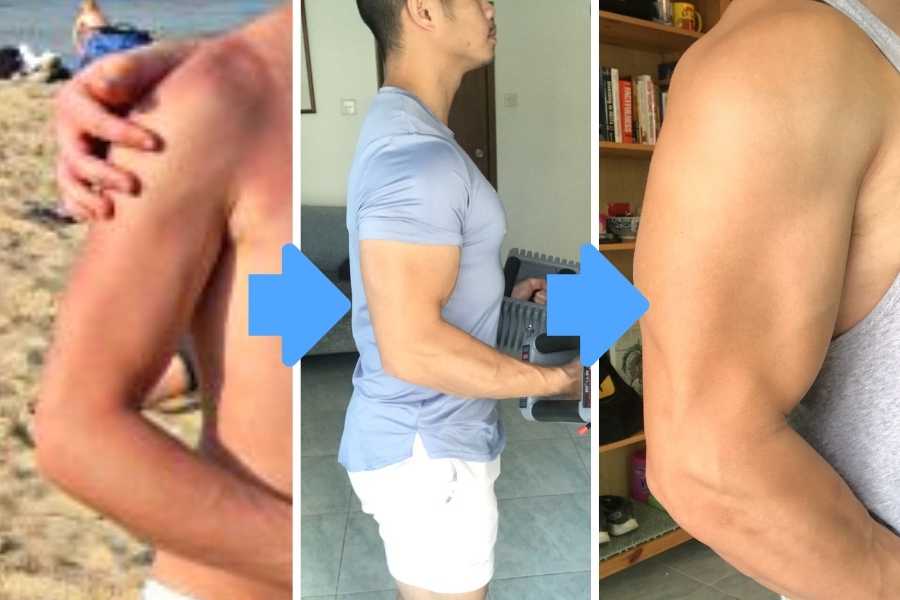
- Key Takeaways
- Bicep Curl Weight For The Average Person
- Specific Bicep Curl Weight Standards
- Factors Affecting Your Ideal Bicep Curl Weight
- Difference Between Dumbbell, Barbell, And Cable Curl Weight
- Are Light Or Heavy Bicep Curls Better?
- 4 Reasons To Avoid Heavy Bicep Curls
- Other Weight Standards For Bicep Curl Muscles
- Conclusion
Key Takeaways
- The average male novice should be able to bicep curl around 20% of his body weight for 1 rep.
- The average female novice should be able to bicep curl around 10% of her body weight for 1 rep.
- Bicep curl weight standards vary depending on body weight, rep range, experience, gender, and equipment.
- The ideal weight for bicep curls is one that is light enough to allow you to lift with good form, but heavy enough to fatigue the biceps in each set.
- Lift in a moderate-high rep range of 10-15 reps per set for optimal arm growth.
Bicep Curl Weight For The Average Person
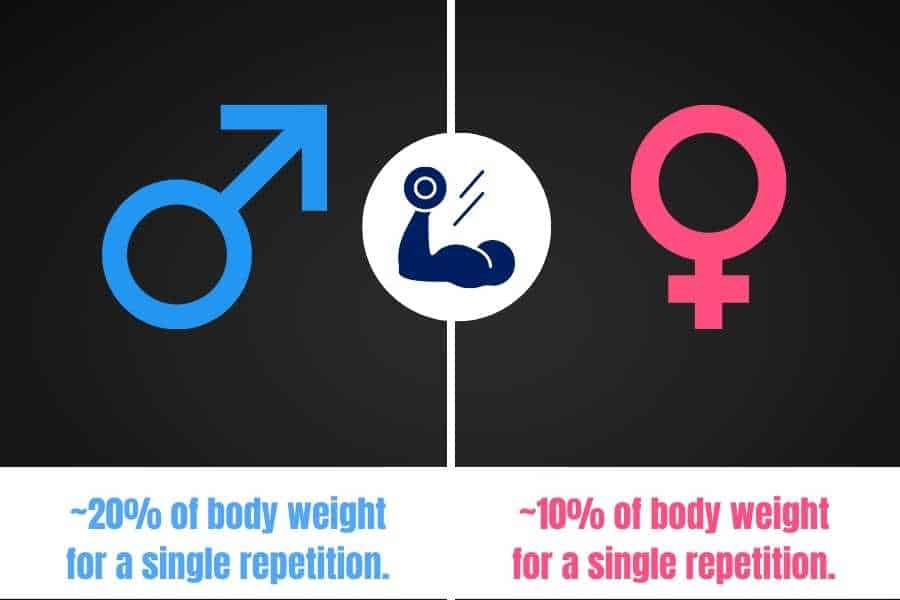
Let’s first start with some benchmark numbers. What weight should the average person be able to bicep curl with a dumbbell?
The average male novice with 6 months of bicep curl training should be able to lift approximately 20% of body weight for a single repetition. In contrast, females should be able to lift 10% of their body weight. Lighter weights should be used for higher rep ranges.
So if you’re a newbie and you can curl the above standards, then you can be confident that you’re lifting a good amount of weight.
However, these are just generalized average bicep curl weight standards for men and women. And there really is no “one size fits all” when it comes to the ideal weight to lift.
Everyone is different and how much weight you should be curling is heavily dependent on your training level and the rep range (how many consecutive reps you’re lifting).
Specific Bicep Curl Weight Standards
The table below shows how much weight you should be dumbbell curling for 10-reps (a good rep range for arms), according to your training level and body weight.
Bicep curl weight standards:
| Body Weight | Beginner 10-Rep Bicep Curl (1 Month Training) | Novice 10-Rep Bicep Curl (6 Months Training) | Intermediate 10-Rep Bicep Curl (2 Years Training) |
|---|---|---|---|
| 120 lb | 6 lb | 14 lb | 27 lb |
| 140 lb | 7 lb | 17 lb | 31 lb |
| 160 lb | 10 lb | 20 lb | 35 lb |
| 180 lb | 12 lb | 23 lb | 38 lb |
| 200 lb | 13 lb | 25 lb | 42 lb |
| 220 lb | 16 lb | 28 lb | 45 lb |
| 240 lb | 17 lb | 30 lb | 48 lb |
| 260 lb | 19 lb | 33 lb | 51 lb |
| 280 lb | 21 lb | 35 lb | 54 lb |
| 300 lb | 22 lb | 37 lb | 56 lb |
| Average: | 14 lb | 26 lb | 43 lb |
Male standards (females should lift ~50% of the weights given). Weights are per dumbbell.
If you’re currently wondering what your ideal bicep curling weight is, then the above standards are a good place to start.
Similarly, you may have been curling for a while. If so, and you’re matching or exceeding these standards, then you know you’re lifting a good and respectable weight to build arm muscle.
Note: the above standards are for a 10-rep range. To adjust for different rep ranges, you can add/minus 1lb per rep less/more than 10 (respectively).
For example- to convert a 16lbs dumbbell curl from 10 to 12 reps, you would minus 2lbs to give you 14lbs.
For more details on how to choose the right training volume to explode your biceps, you can check out my guide on lifting the right number of sets and reps for arms.
Factors Affecting Your Ideal Bicep Curl Weight
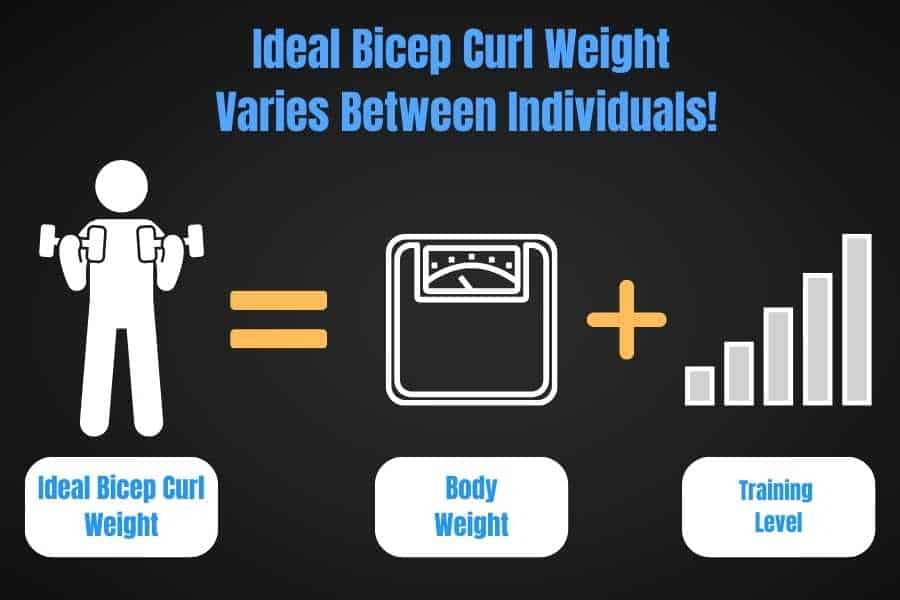
As I mentioned previously, everyone has different strength standards for their bicep curl.
Here are the 6 main factors that determine the ideal weight you should be lifting for your bicep curl:
- Body weight. Heavier people generally have more muscle mass and can curl heavier weights.
- Training level. Experienced lifters can generally curl heavier weights that represent a higher percentage of their own body weight, compared to beginners.
- Rep range. Working in high rep ranges involves lifting lighter weights (and vice versa).
- Gender. Men have more muscle mass compared to women and can therefore curl heavier weights.
- Bicep curl variation. Lots of bicep curl variations exist and some are harder to perform than others (e.g. overhand curls). Harder variations do not allow you to lift as much weight. You can check out my other post to find out how to pick the ideal number of bicep exercises to include in your program to build bigger arms.
- Experience with compound bicep movements. Compound pulling movements such as dumbbell rows and pull-ups invariably work the biceps too (follow the links for the respective weight standards). People who regularly practice these exercises can expect to have an above-average bicep curl, compared to someone who does not do compound pulling.
Additionally, your preferred bicep curl equipment also affects how much weight you should be lifting (see next).
Difference Between Dumbbell, Barbell, And Cable Curl Weight
Bicep curls are most commonly performed using dumbbells, barbells, and cable machines.
Generally speaking, most people can dumbbell curl around 45% of the weight that they could otherwise lift using a barbell or cable machine. This is because dumbbells are inherently less stable and therefore allow for less weight to be lifted.
The table below gives you an idea of how different types of equipment affect your bicep curl weight standard:
| Curling Equipment | Bicep Curl Weight For A 200lb Male Novice With 6 Months Of Training |
|---|---|
| Dumbbell | 36lbs (per dumbbell) |
| Barbell | 80lbs |
| Cable machine | 75lbs |
Note: weight standards are for a 1-rep max (maximum weight liftable for a single repetition).
Are Light Or Heavy Bicep Curls Better?
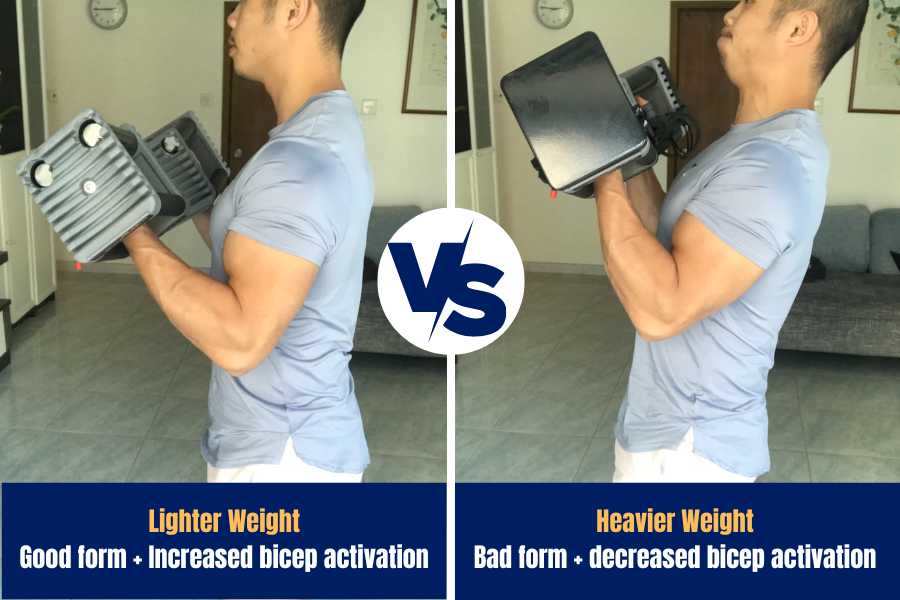
As you know, bicep curling in a low rep range (e.g. 5 reps) allows you to lift more weight compared to curling in a high rep range (e.g. 15 reps).
So which is it better- lifting heavy weights for low reps or light weights for high reps?
As a general rule, lifting in a moderately-high rep range of 8-12 reps is best for bicep growth. Lighter weights allow good form to be maintained, and this maximizes biceps activation. In contrast, heavier weights can compromise form and decrease bicep activation.
Conventional weightlifting consensus tells us that lifting heavier weights = more muscle growth.
However, there’s an exception to the rule when it comes to training smaller muscles such as the biceps.
Below, 4 experts explain why.
4 Reasons To Avoid Heavy Bicep Curls
The biceps can be difficult muscles to grow. Additionally, there are many mistakes beginners can make when trying to build bigger arms. And one of the most common mistakes is choosing the wrong rep range and weight.
Here are the 4 experts who gave their opinions on whether to curl heavy or light:
| Expert | Qualification |
|---|---|
| Jeff Nippard | Professional Natural Bodybuilder & Powerlifter |
| Jeff Cavaliere | Certified Strength & Conditioning Specialist |
| Jeremy Ethier | NASM-Certified Trainer |
| Mike Dewar | Certified Strength & Conditioning Specialist |
All 4 experts unanimously agree that the majority of your bicep curls should be done with lighter weights performed at a moderate-high rep range.
This, by the way, means “lighter” relative to the big compound lifts such as rows and pull-ups.
You still need to lift a weight that challenges you for the allotted rep range.
Here are 4 of the most commonly quoted reasons why you shouldn’t bicep curl with weights that are too heavy:
1) Eccentric Phase Is Compromised.
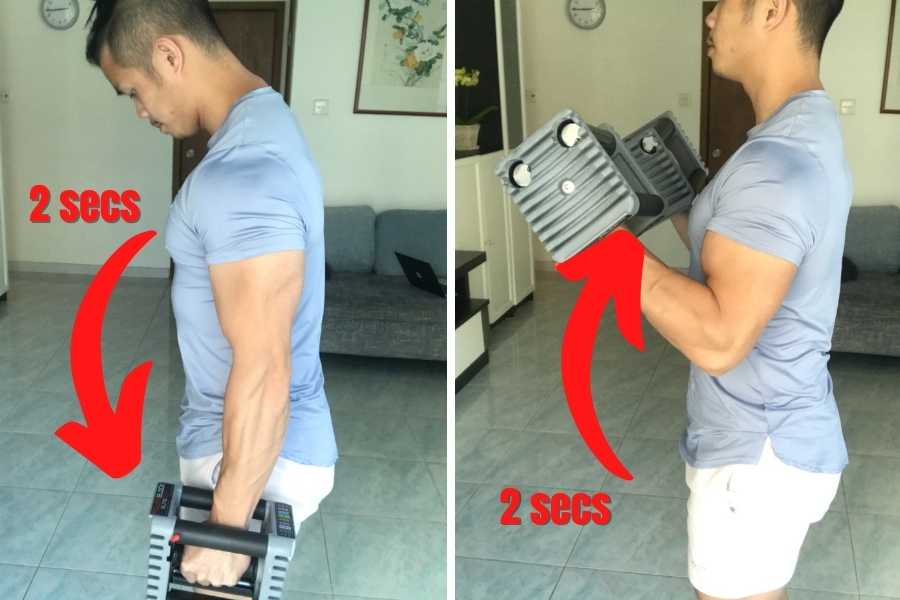
Like all weight lifting exercises, the bicep curl consists of an upward movement (concentric) and a downward movement (eccentric).
Jeff Nippard explains that both concentric and eccentric phases should be performed in a slow and controlled manner.
He further advises you to squeeze your bicep at the top of the concentric phase, and lower the weight back down slowly to work your bicep maximally on the eccentric phase.
The eccentric phase is particularly important.
In fact, a 2017 study showed the eccentric phase is more beneficial for hypertrophy (muscle growth) compared to the concentric phase.
This form of controlled bicep training simply can’t be achieved if your weights are too heavy.
Instead, keep your bicep curl to moderate weights and focus on controlling your concentric and eccentric contractions.
If you’re looking to buy dumbbells to build bigger arms at home, you can check out my other post which explains how to choose the ideal dumbell weight to build arm muscle.
2) Form Breaks Down.
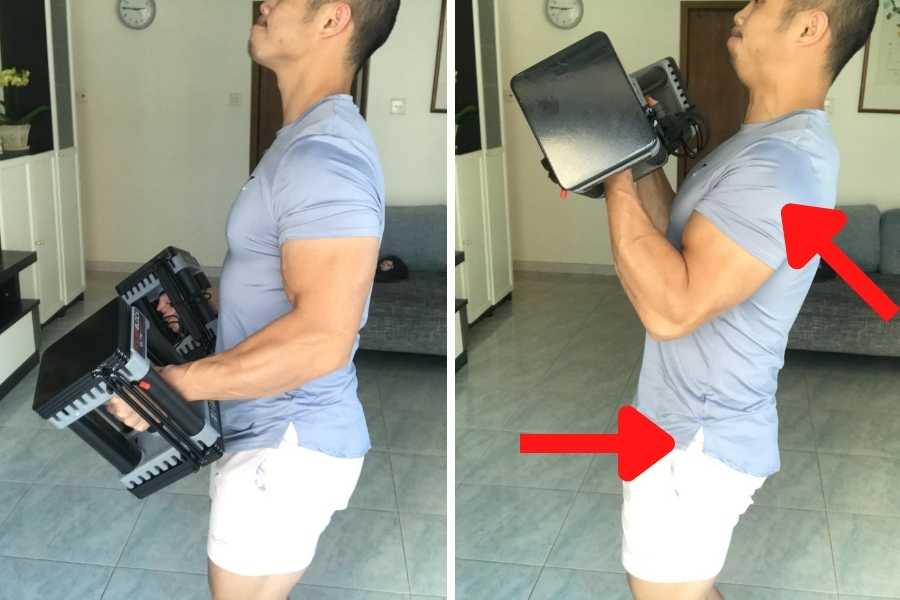
What a cheat lifting looks like for a bicep curl using a weight that is too heavy.
Good Weight lifting form refers to adopting practices to safely and exclusively activate the target muscles. In this case, the biceps.
Jeremy Ethier explains that using too heavy a dumbbell encourages you to recruit neighboring muscles to assist the bicep curl movement (also called “cheating).
Cheat lifting in a bicep curl can inadvertently recruit the front deltoids (shoulders) and trapezius (upper back), thereby reducing biceps activation.
A telltale sign you are lifting too much weight on the bicep curl is if your shoulders move forward and upward as you curl a dumbbell. The shoulders should remain relatively motionless throughout the curl.
Jeff Nippard also adds that using dumbbells that are too heavy will often cause you to use assistance from your hips and legs to help “hoist” a dumbbell upwards.
These are both examples of sacrificing form for heavy weights, and should be avoided.
Instead, you should perform lighter-weight bicep curls with good form to maximize bicep engagement.
3) Heavy Weights Promote Cheating.

Jeremy Ethier points out that “cheat lifts” are a common consequence of curling a heavy weight that your biceps can’t handle.
As a result, you start using bodyweight momentum to help you swing the dumbbell upward. This in turn reduces the bicep curl range of motion and prevents you from achieving a good “bicep squeeze”.
When you cheat, you’ll limit your bicep growth potential.
This has been shown in a 2012 study that found that a partial range of motion (i.e. the dumbbell not traveling fully up and down during a cheat lift) reduces bicep growth by 9%.
Additionally, another 2018 study found that those who lifted heavier weights but failed to fully squeeze the bicep saw 5.5% less bicep growth compared to those who achieved a good bicep squeeze with lighter weights.
Therefore you should use light-moderate weight for bicep curls– one that challenges you but also allows for good lifting form.
4) Heavy Bicep Curls Do Not Develop Mind-Muscle Connection.
Mind-muscle connection refers to the conscious effort to activate a muscle.
Jeff Cavalier highlights the importance of performing lighter-weight bicep curls to maximize your mind-muscle connection.
By using a lighter weight, you’re able to actively feel your bicep contract as you perform a curl. This will prevent cheat lifting, and also help you to quickly develop bicep strength.
Jeff further also notes that once you have gained a solid foundation of bicep strength, you can then start to add more weight.
For more details on how to add weight to your bicep curl, you can check out my other post on progressive overloading with dumbbells.
Other Weight Standards For Bicep Curl Muscles
The dumbbell curl primarily works the biceps. Here are weight standards for other exercises that hit similar muscle groups:
- Dumbbell row– compound back movement that works the biceps as secondary drivers.
- Pull-up– another compound back movement that also works the biceps.
Conclusion
The ideal weight for bicep curls is one that allows you to lift with good form as well as challenge you for the allotted rep range.
Moderate-high rep ranges of 8-15 reps are ideal for building bigger biceps.
For most novices, 10-20lb dumbbells are a good weight to start lifting for this rep range.
However, be aware that weight standards can vary considerably depending on your body weight, rep range, gender, and experience.
You may also be interested in the downloadable Kalibre Blueprint PDF which details exactly how I gained 40lbs of lean muscle (it’s 100% free!). It details the exact exercises and nutrition (with printables) I used to go from skinny to ripped!


